Did you know that anime has become hugely popular all around the world? It’s not hard to see why. With its mix of animation and stories, it draws in viewers of all ages, especially the youth. But what’s the big deal about anime’s stories?
For starters, anime isn’t limited by the rules of reality like most movies are. This means animators can dream up incredibly detailed and visually stunning tales. They can make up new worlds, crazy creatures, and magic. This creative liberty makes anime stories unforgettable.
Another great thing about anime is how many types there are. From heart-pounding action to tear-jerking dramas, there’s a genre for everyone. This means the anime world is open to all, offering a mix of fun plots and serious themes. Its variety is one of the reasons it’s loved by so many.
But there’s more to anime’s charm. Its stories really know how to tug at your heartstrings. Your favorite anime likely has characters you love and scenes that make you feel deeply. This connection is what makes anime’s storytelling so strong. It’s all about the emotions and the impact.
Key Takeaways:
- Anime combines animation and storytelling to create a captivating art form that engages audiences worldwide.
- The freedom of animation allows for the creation of visually stunning stories and unique worlds.
- Anime covers a wide range of genres, appealing to diverse audiences.
- Emotional impact, interest, and meaning are essential elements of effective anime storytelling.
- Anime’s power lies in its ability to forge a strong connection between the audience and the narrative.
The Freedom of Animation in Anime
Anime is different from regular movies because it can go beyond our world’s limits. The creators can make up new places, creatures, and characters freely. This gives them the chance to tell stories in ways that real-world movies can’t.
With animation, anime dives into complex stories with amazing visuals. This is hard to do with real actors. It uses special animation techniques to make the stories more interesting and beautiful. It all makes the anime more exciting to watch.
Computer-generated imagery (CGI) is a big part of how anime looks so good. It helps blend digital parts into the animation smoothly. This makes action scenes, landscapes, and characters look stunning. The anime is all the more attractive because of it.
From cool fight scenes to detailed faces, anime’s animation has a special touch. It makes the stories come to life in a way that’s hard to forget. It’s always changing and finding new ways to be creative.
Wall-E (2008), a film with environmental themes, took a unique approach by having no dialogue for much of its duration. This creative decision resonates with storytelling styles seen in anime.
Animation gives anime the endless chance to build amazing worlds and characters. Fans from all over love anime for its beautiful and imaginative stories. It proves that animation is a powerful way to tell stories.
The Immersive Characters of Anime
Anime is special because it makes characters that draw you into their world. They stand out with their looks, personalities, and what they can do. Unlike real-life movies, anime characters have no rules, just endless creativity. There’s a lot of space for them to grow and change, letting us learn even more about them.
Shows like Naruto, One Piece, and Bleach, known as the “Big Three,” tell stories that grab you. They show young characters growing and finding themselves. This journey feels real to lots of people, keeping them hooked.
Anime tells its stories differently from Western shows. There aren’t always clear good guys and bad guys. In many Western stories, it’s grown-ups who save the day, but in anime, we learn through young eyes. They deal with big ideas while trying to figure themselves out.
Also, anime doesn’t drag out its plots. It takes small steps in every episode, which keeps viewers wanting more. The story always moves forward, which makes us root for the characters more and more.
Anime is really good at making you feel with its story and characters. You go through all sorts of emotions, from being happy to sad. This pulls you into the story even deeper.
The characters in anime are key to its success. We see ourselves in their struggles and victories, which makes us care even more. This emotional bond is why anime is loved by so many. It’s more than just a show; it feels like a friend.
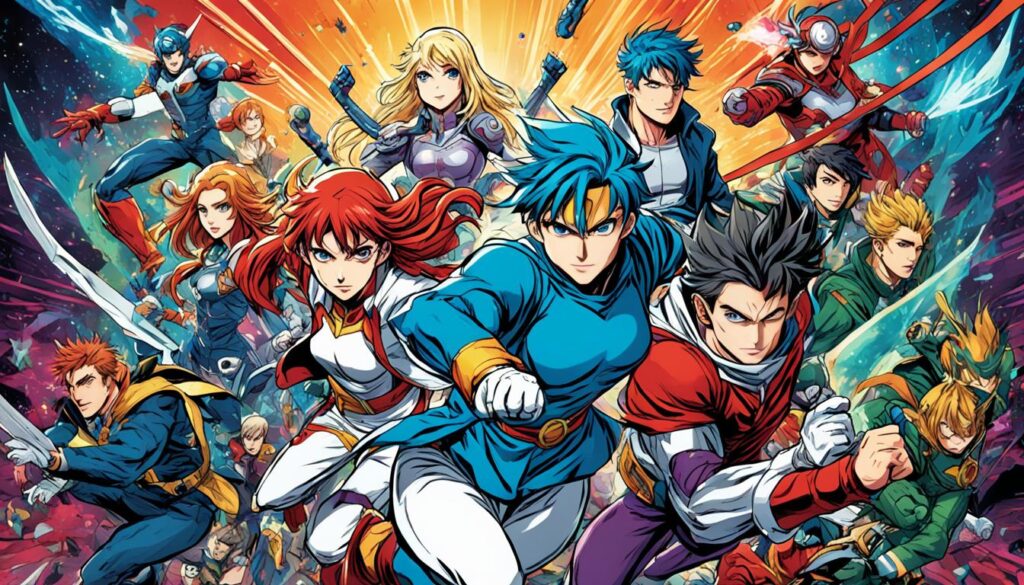
| Anime Series | Debut Year | Number of Episodes | Themes |
|---|---|---|---|
| Naruto | 1999 | 720+ | Friendship, perseverance, pursuit of dreams |
| One Piece | 1999 | 1000+ | Friendship, loyalty, pursuit of freedom |
| Bleach | 2004 | 366 | Identity, duty, consequences of power |
The Variety of Genres in Anime
Anime comes in many genres, each serving unique tastes and interests. You might love the thrill of action-packed series or feel deeply through emotional dramas. Whatever you like, anime has a genre for you.
The beauty of anime lies in its endless themes and styles. Each genre offers a fresh story and a new way to captivate its audience. This variety keeps the anime world exciting and full of surprises.
For kids under 12, there’s Kodomomuke anime. It’s all about action, adventure, and humor, making it perfect for little ones. They’ll find excitement and fun in this genre.
Shonen anime targets boys aged 12-18. It includes classics such as Naruto and Dragon Ball. With exciting adventures and epic battles, it’s perfect for those seeking action.
Shojo anime, on the other hand, aims at girls aged 12-18 who love romance and drama. Series like Fruits Basket and Sailor Moon touch on themes like friendship and self-discovery. For a heartfelt, girly experience, this genre is the way to go.
Seinen anime appeals to adult men, offering mature content. It explores dark themes and genres like psychological and action. For a deeper, more adult story, Seinen anime is a go-to.
Josei anime, made for adult women, focuses on real-life situations and relationships. It features real-life scenarios and adult themes. If you’re looking for something relatable, give Josei anime a try.
Each anime genre also includes many sub-genres, from Mecha to Idol. These sub-genres offer even more diverse storytelling. Whether it’s Mecha’s futuristic technology or Isekai’s parallel worlds, there’s always something fresh to explore.
The wide array of anime genres is truly one of its best features. It caters to varied tastes, drawing in different audiences with every story. This rich diversity is what makes the anime world so vibrant and fascinating.
The Unique Storytelling Techniques in Anime
Anime stands out because of how it tells stories. It uses techniques that really grab your attention and make you feel part of the story. These include focusing on making you feel things deeply, surprising you with the story, and wrapping up the story bit by bit. This way, anime keeps you interested and wanting more. Now, let’s dive deeper into these cool techniques.
Emotional Impact:
Anime is amazing at making you feel a wide range of emotions. It does this by creating stories with deep conflicts and characters you can really relate to. You might feel excited, happy, sad, or even very down. But no matter what, there’s always a strong emotional connection that makes the story feel real.
Plot Twists:
One thing anime does well is surprising you with sudden turns in the story. These surprise moments keep you on the edge of your seat, wondering what will happen next. It could be a big reveal, a character change, or a really shocking event. These twists add a lot of suspense and fun to watching anime.
Episodic Resolutions:
Anime moves the story forward in every episode, giving you some answers while still making you curious for more. Unlike Western shows that might take seasons to finish a story, anime does it episode by episode. This way, every episode feels important and satisfying without giving away too much. It’s a smart way to keep the story going and the viewers happy.
| Anime Storytelling Techniques | Impact on Narrative |
|---|---|
| Emotional Engagement | Elicits a deep emotional connection with the audience, enhancing their overall experience. |
| Plot Twists | Keeps viewers engaged, intrigued, and surprised, adding excitement to the narrative. |
| Episodic Resolutions | Provides closure and awareness within each episode, ensuring a satisfying viewing experience while maintaining an ongoing narrative. |
These techniques make anime super popular and enjoyable to watch. By making you feel deeply, surprising you, and keeping the story moving, anime tells stories that really stick with you. Whether it’s about a teen’s big adventure, heroes that might be villains, or many different kinds of stories, anime keeps finding new ways to make us love storytelling.
The Balance Between Consistency and Creativity in Anime Storytelling
Anime strikes a balance between being one-of-a-kind and making sense. It mixes fantasy with a strict logic. This combination gives new life to things like magic and character growth. And all the while, it tells stories that make sense.
Watching anime means diving into worlds where your imagination can run wild. Whether it’s the epic fights in “Naruto” or the magical adventures of “Spirited Away,” each story is unique. These tales have captured the hearts of many because of their creativity.
For some, loving anime isn’t just about watching. They take their passion further by writing their own stories. They pull ideas from their favorite shows. This creativity shows anime’s ability to spark deep thought and imagination.
Anime often tugs at our heartstrings, creating a special bond with its viewers. The feelings characters express can be strong, just like in real life. This makes the stories more relatable and emotional for everyone watching.
Creating anime takes a lot of careful planning, especially with the money needed. The budget is split in many different ways, such as to studios and broadcasters. Some shows draw big broadcasting fees, sometimes needing millions of yen.
Making a single episode of a TV anime takes about three weeks of work. There are usually 300 different scenes to work on. Most animations are drawn by hand, but computers help with the final check. Many talented artists work together to get it right, with about 20 people working on the animation for each episode.
Anime blends consistency with unique storytelling for an unforgettable experience. It uses creativity, a clear logic, and storytelling to draw us in. This mix takes us to amazing places and makes us feel deeply.
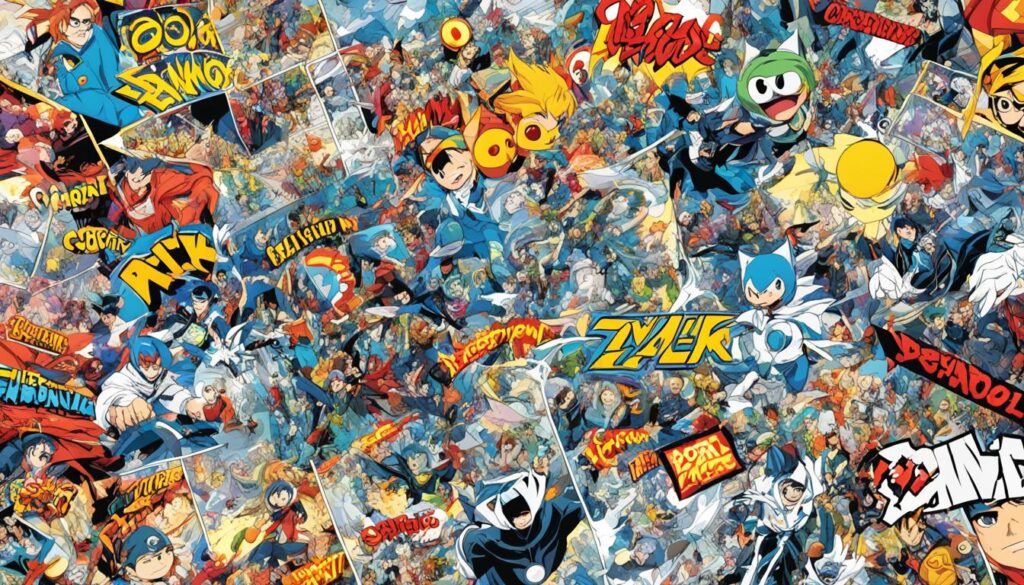
| Key Elements | Budget Allocation | Broadcasting Costs | Production Timeline |
|---|---|---|---|
| Anime Studio | Around half of the budget | – | – |
| Broadcasters and Contributing Companies | Remaining portion | – | – |
| – | – | A late-night timeslot across 5-7 stations for a 52-episode series: approximately 50 million yen | – |
| – | – | – | Storyboard creation for a normal-length TV-anime episode: around 3 weeks |
| – | – | – | An average TV-anime episode: approximately 300 cuts |
| – | – | – | – |
Anime’s Approach to Character Development
Anime really focuses on characters growing, especially young ones. These teenage heroes face big challenges and adventures. They often learn about friendship, courage, or find themselves on their journeys.
Unlike Western tales with older heroes, anime highlights young people. They join unexpected adventures to bring back peace. This makes anime stories different and fresh for fans.
Anime tells stories quicker than Western tales. Episodes often bring emotional satisfaction without long waits. This keeps watchers engaged and wanting more after each episode.
Character evolution is key in anime. Viewers connect deeply as they see characters’ inner struggles and dreams. Realistic flaws make characters relatable, drawing viewers into their lives.
Gaming also values adaptable character arcs. In games like “Mass Effect,” player decisions shape the story. This interactive storytelling enhances the experience for players.
In books, character growth is thoughtful and poignant. Writers like George R.R. Martin make characters deep and real. Through their changes, readers witness rich story arcs.
Characters in anime, games, and books are made compelling by their imperfections and relatability.
Anime, games, and books all make characters feel human. Through flaws and growth, they mirror real life. This draws fans in, creating an emotional bond with the characters.
Anime shines in character development. Its stories are powerful and touching, leaving a lasting impact. By making characters real, viewers feel deeply connected to the tales.
A Comparison of Character Development Approaches
| Medium | Approach |
|---|---|
| Anime | Gradual character development |
| Games | Adaptable and compelling character development |
| Books | Intimate and introspective character development |
Note: The above table highlights the different approaches to character development in anime, games, and books, showcasing how each medium creates compelling and relatable characters in their respective storytelling techniques.
Anime’s Ability to Move the Plot Forward in Each Episode
Anime is famous for its exciting plots that move fast in every episode. Unlike some shows from the West, anime doesn’t stay on one topic too long. It keeps progressing, making the story more interesting as it goes.
With its clever storytelling, anime grabs viewers from the start of each episode. Every single one adds new twists and turns to the story. This keeps things fresh and makes you eager to watch the next episode. It really hooks you into the plot.
Anime loves to dive into different stories and ideas. This mix gives you a full experience. It’s not just about the main story. Anime is like exploring a whole new world with each episode.
Sometimes, you might come across episodes that don’t fully follow the main plot. But even then, anime always goes back to the main story. These episodes often show us more about the characters or add to the main story.
In anime, there’s always something new happening. Creators are always adding new problems, growing characters, and solving mysteries. This keeps the show exciting. It’s how they make sure you never get bored.
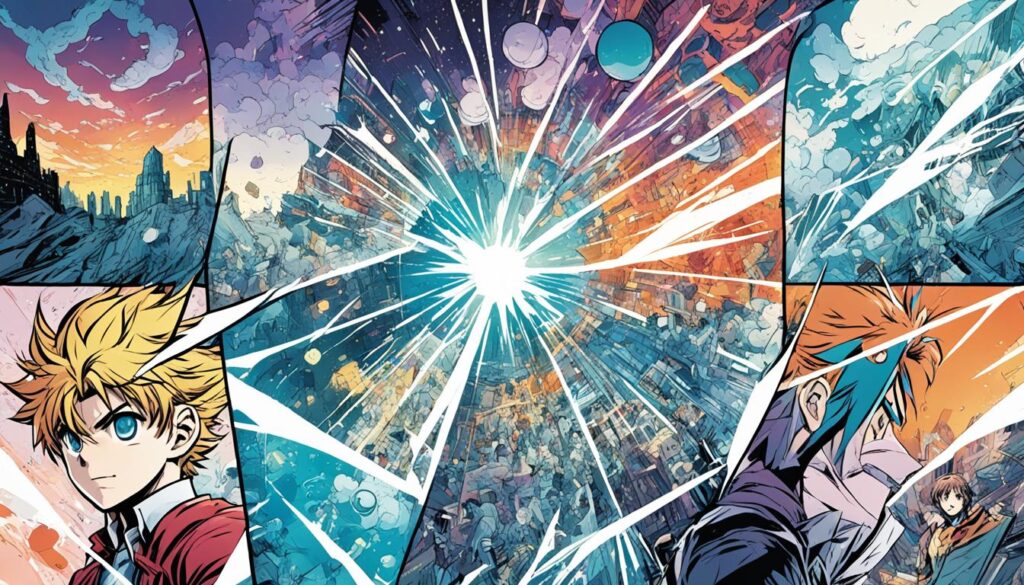
“Anime’s ability to move the plot forward in each episode is a testament to its storytelling excellence. By avoiding stagnation and continuously introducing new elements, anime keeps viewers invested and eager to discover what happens next.”
Simply put, anime never stops being interesting. It’s always moving, and that’s what keeps fans around. Anime’s way of telling stories is what makes it beloved around the world.
The Sense of Closure and Thoughtfulness in Anime
Anime often leaves us with mysteries, making us eager to know more. It’s really good at slowly solving these mysteries as the story moves forward. This mix of solving some questions while keeping us curious adds depth.
The world of anime can hook you with its puzzles and secrets. Each episode seems to give you a bit more of the answer, keeping you excited. It’s like a promise that they’ll eventually explain it all.
At the end of a season or series, anime usually ties up its main plot points. Even if some secrets are kept, you feel like you’ve got a good enough answer. This mix of solving things while still keeping a bit of mystery is engaging.
Take “Puella Magi Madoka Magica” for example. It keeps a lot hidden about the characters and their world at first. But, as it goes on, you get these big reveals that really hit home. The ending is satisfying yet makes you think, leaving a deep impact.
Anime knows just how to wrap things up while still being thoughtful. This lets the audience dive deep into the story and its messages. It’s a big reason why anime is loved by many for its unique approach to storytelling.
Anime’s Emotional Effect, Interest, and Meaning
Anime has a special way of creating deep emotions, capturing our interest, and telling stories that matter. It uses different storytelling methods to touch our hearts and thoughts.
Anime builds its stories with deep conflicts. These struggles help characters face their inner battles, making their stories feel real and interesting. Whether in a big fight or a personal issue, anime makes these struggles hit home, bringing out various emotions.
“Anime explores deep topics and feelings not common in the West. It talks about big questions, looks into spirituality, and even questions culture. This makes anime rich and makes us think deeply.”
What makes us care in anime are the characters. They grow, face their fears, and accept who they are. Watching them develop connects us to the story emotionally, making it more impactful.
“Anime characters are like real friends and heroes. Watching their ups and downs touches our hearts deeply.”
Another reason anime draws us in is how it tells its story. Each scene has meaning, pushing the story forward and keeping us hooked. The mix of suspense, drama, and surprising turns makes us eager for more.
Anime tells stories on many themes, with complex feelings and deep messages. It talks about love, loss, justice, and even politics. This makes it a rich tapestry of human experiences.
Let’s look at a table to see how anime hits us emotionally, keeps us interested, and shows deep meanings:
| Emotional Effect | Interest | Meaning |
|---|---|---|
| Anime makes us deeply connect with its stories, leading us to laugh, cry, and feel a range of emotions. | The way stories are told and characters are built make us care, keeping us glued to the plot. | By exploring big themes and deep stories, anime offers us new insights and makes us think. |
| Its stunning art and visuals elevate our emotions, making watching it a beautiful experience. | The many unique tales in anime ensure there is always something fresh and interesting for everyone. | It introduces us to Japan’s culture, traditions, and art, fostering cultural understanding. |
In sum, anime is powerful for triggering emotions, keeping us engaged, and telling stories that matter. It stands out by focusing on strong emotions, impactful conflicts, and characters we can relate to. This is why it has a strong fan base worldwide.
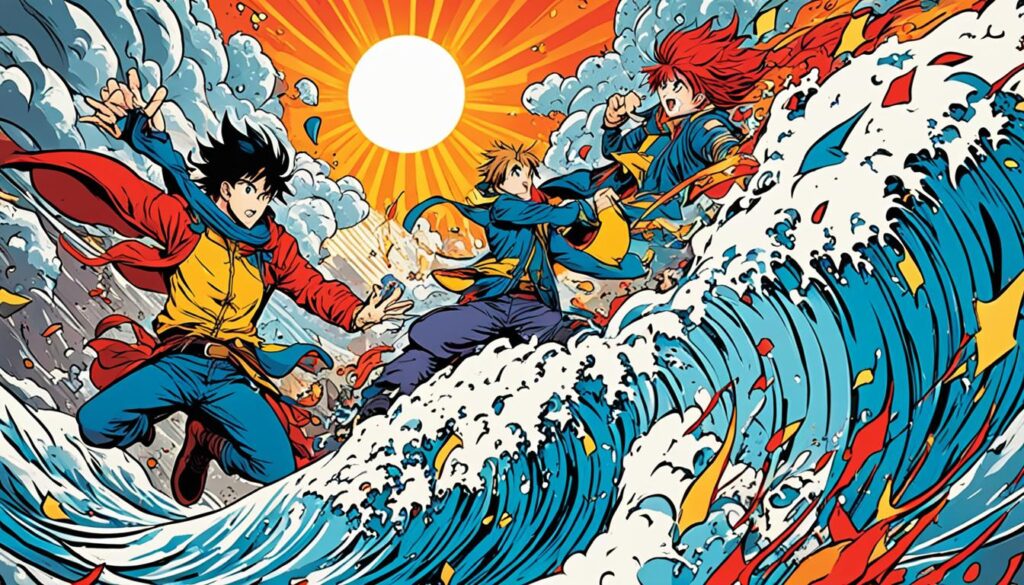
Anime’s Consistency and Logic in Storytelling
Anime storytelling is known for keeping things logical, even with its wild elements. It mixes magic, high-tech gadgets, and personal growth in ways that make sense. This logic makes viewers really feel part of the story. Even when it’s all made up, fans still believe in the world anime shows them.
Emotions, interest, and thought are key in anime. It’s not just about fun; it gets us thinking. With a clear and consistent story, anime feels real. This connection enhances the joy of watching.
“Anime storytelling is a masterclass in maintaining logical consistency while exploring fantastical elements. It’s this attention to detail that keeps us engaged and invested in the story.” – Anime enthusiast
Great anime shows stand out with their original stories. They keep viewers hooked as they unfold bit by bit. Each episode reveals something new, making fans want to see more. This urge builds excitement for what comes next.
As stories wrap up, anime answers key questions and solves puzzles. Series like Baccano! and Steins;Gate are famous for their intricate plots. They combine complexity with clear explanations, leaving a strong impression on fans.
Interpretation of Fantastical Elements
Anime uses fantasy to tell deep and intriguing stories. Some shows, like Shinsekai Yori, feel both real and magical. They look at big questions about life through fantastical worlds.
But not all anime gets the mix right. While series like Code Geass can be over the top, others, like Cowboy Bebop, make sure their worlds and rules make sense. This balance helps fans get lost in the story without getting confused.
Many shows use special ideas to tell their stories better. Fate and time travel are big themes in anime. Favourites like Berserk (1997) and Steins;Gate use them to create deep and interesting stories.
Then there are series like Baccano! that connect stories in smart and surprising ways. These shows impress by keeping their plots organized, even when they’re really complex.
Comedy anime sometimes chooses laughter over story rules. They set up funny situations that break their usual logic. This makes their humor unexpected and enjoyable.
Anime stands out for mixing logic with creativity so well. Its focus on detail keeps viewers entertained and connected. This popularity shows how anime has become a beloved part of entertainment everywhere.
Anime’s Creativity and Uniqueness in Storytelling
Anime stands out for its unmatched creativity and unique stories. Each series has its own special way of telling a story. But what makes anime special is how it twists and turns these stories. It surprises viewers by breaking common storytelling rules.
Anime keeps its stories interesting by adding unusual twists. This makes each anime feel different and new. It grabs people’s attention with its out-of-the-box storytelling.
For instance, “Attack on Titan” is a great example. It uses a well-known end-of-the-world theme but with massive human-eating creatures. This change makes the story deeper and more gripping. Viewers love the unexpected elements in this series.
Then, there’s “Puella Magi Madoka Magica.” It starts off looking like a usual story about magical girls. But it becomes darker and more complex. The series focuses on tough choices and feeling hopeless. It makes people think deeply and touches their hearts.
Anime also shines through its beautiful art and design. The characters, the worlds they live in, and the dazzling animations are all beautifully made. Anime’s visual effects and rich colors create a world that draws you in.
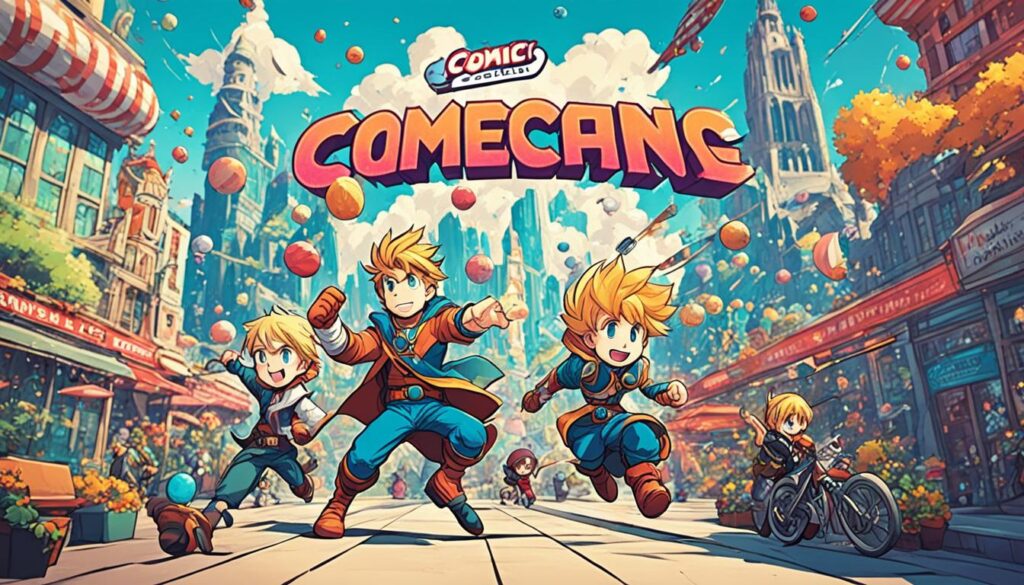
| Statistics | Data |
|---|---|
| Percentage of global audience captivated by anime and manga’s unique storytelling and art styles | 73% |
| Ratio of animated films, television series, and web series in the anime sector compared to printed and illustrated narratives in manga | 2:1 |
| Number of anime-inspired merchandise, cosplay events, and themed cafes in Japan | Thousands |
| Increase in global recognition of anime in recent decades, highlighted by the success of Studio Ghibli films | Significant |
| Growth rate of the anime and manga industry in Japan and internationally | Rapid |
Anime’s innovative storytelling is a big reason for its worldwide success. By constantly thinking outside the box, anime grips people from all cultures. It persists in being a major entertainment source.
Conclusion
Anime has become a worldwide hit because of its unique way of storytelling and beautiful animation. It mixes emotions, amazing art, and various story types to keep its fans hooked from all around the world.
Anime shines in bringing characters to life and making us feel deeply for them. Characters look different, act uniquely, and have special skills. This makes us care more about them and their stories.
Also, anime does well in mixing the unusual with the believable in its plots. Even with fantasy, viewers find something logical to hold on to. This mix of the strange and the real makes anime stand out.
In general, anime tells stories that are simple, clear, and grab your attention. It builds trust with the audience and draws them into its world. This is what makes anime an amazing storyteller and a beloved form of art.
FAQ
What makes anime storytelling unique?
Anime tells stories in a way that mixes animation with complex tales. It ends up looking amazing on screen.
How does animation contribute to the storytelling in anime?
Animation offers endless possibilities. It allows for worlds, creatures, and characters that step beyond reality. This makes the story even more engaging.
Why do anime characters stand out?
Anime characters are memorable for their unique looks, traits, and skills. These elements bring them to life, creating a deep connection with the audience.
What types of genres can be found in anime?
Anime spans a vast range of genres. It caters to many tastes with action shows, dramas, and much more.
What storytelling techniques are commonly used in anime?
Emotion is central in anime stories. They often include deep conflicts, interesting characters, and unexpected turns. This keeps the audience hooked.
How does anime achieve a balance between consistency and creativity?
Anime mixes creative elements with consistent storytelling. It tells extraordinary stories within a logical framework, giving the plots realism.
How does anime approach character development?
Anime explores character growth through various tales. Coming of age stories are a common theme. This approach adds layers to the storytelling, making it relatable.
Does anime progress the plot in each episode?
Yes, anime keeps plots moving with each episode. It avoids dwelling too long on one point and introduces new plot elements continuously.
Does anime provide closure at the end of each season?
There’s often a mix of answers and new questions at the end of seasons. This approach combines closure with elements that keep fans guessing.
How does anime evoke emotional effects and generate interest?
Anime crafts powerful conflicts and characters. It imbues every scene with meaning, touching the emotions and minds of viewers, creating anticipation for what’s to come.
Does anime maintain a sense of logical consistency?
Even with fantastical elements, anime holds logical consistency. It explains magic and tech in believable ways within its world’s rules.
What makes anime storytelling creative and unique?
Anime uses familiar story structures in surprising ways. It often turns expectations on their head. This makes anime’s narratives unique and refreshing.
Why is anime considered a captivating art form?
Its blend of animation, deep emotional stories, and varied genres make anime captivating. It draws in viewers from all over the globe.
Source Links
- https://aestranger.com/embracing-anime-storytelling/
- https://www.piggyride.com/blog/what-makes-storytelling-effective-in-anime/
- https://keyframemagazine.org/2020/08/14/the-influence-of-anime/
- https://wavemotioncannon.com/2016/01/08/why-over-sixty-years-of-animation-history-still-remains-obscure/
- https://medium.com/@mathodiamehul/exploring-the-big-three-anime-a-triumvirate-of-immersive-storytelling-1d3efda77779
- https://beebom.com/anime-types-genres-explained/
- https://collider.com/major-genres-anime-explained/
- https://www.cbr.com/greatest-anime-subgenres-ranked/
- https://ingostudio.com/storytelling/anime-storytelling/
- https://medium.com/@jlatales/the-transformative-power-of-storytelling-lessons-from-a-naruto-fan-eebbb3657091
- https://washiblog.wordpress.com/2011/01/18/anime-production-detailed-guide-to-how-anime-is-made-and-the-talent-behind-it/
- https://www.creativewritingnews.com/unveiling-the-craft-the-art-of-character-development-in-anime-games-and-books/
- https://comicsormanga.home.blog/
- https://www.s1e1.com/2021/09/10/playing-in-anothers-sandbox-wonder-egg-priority-and-finding-personal-meaning-in-messy-storytelling/
- https://medium.com/@chrissteven743/the-power-of-anime-why-everyone-should-watch-it-f4c1523c2991
- https://www.toki.tokyo/blogt/2023/8/9/anime-and-manga-exploring-a-cultural-phenomenon
- https://www.reddit.com/r/anime/comments/4s82il/styles_of_narrative_in_anime/
- https://homearthaven.com/blogs/news/the-art-behind-anime-uncovering-the-creative-process-of-japans-animation-masters
- https://www.outcomehabits.com/p/lead-people-to-the-conclusion-with
- https://www.linkedin.com/pulse/art-ending-making-your-storys-conclusion-impactful-its-bob-roitblat-85yxc
- https://nathanieltower.com/how-to-end-a-short-story-tips-for-a-compelling-conclusion/
